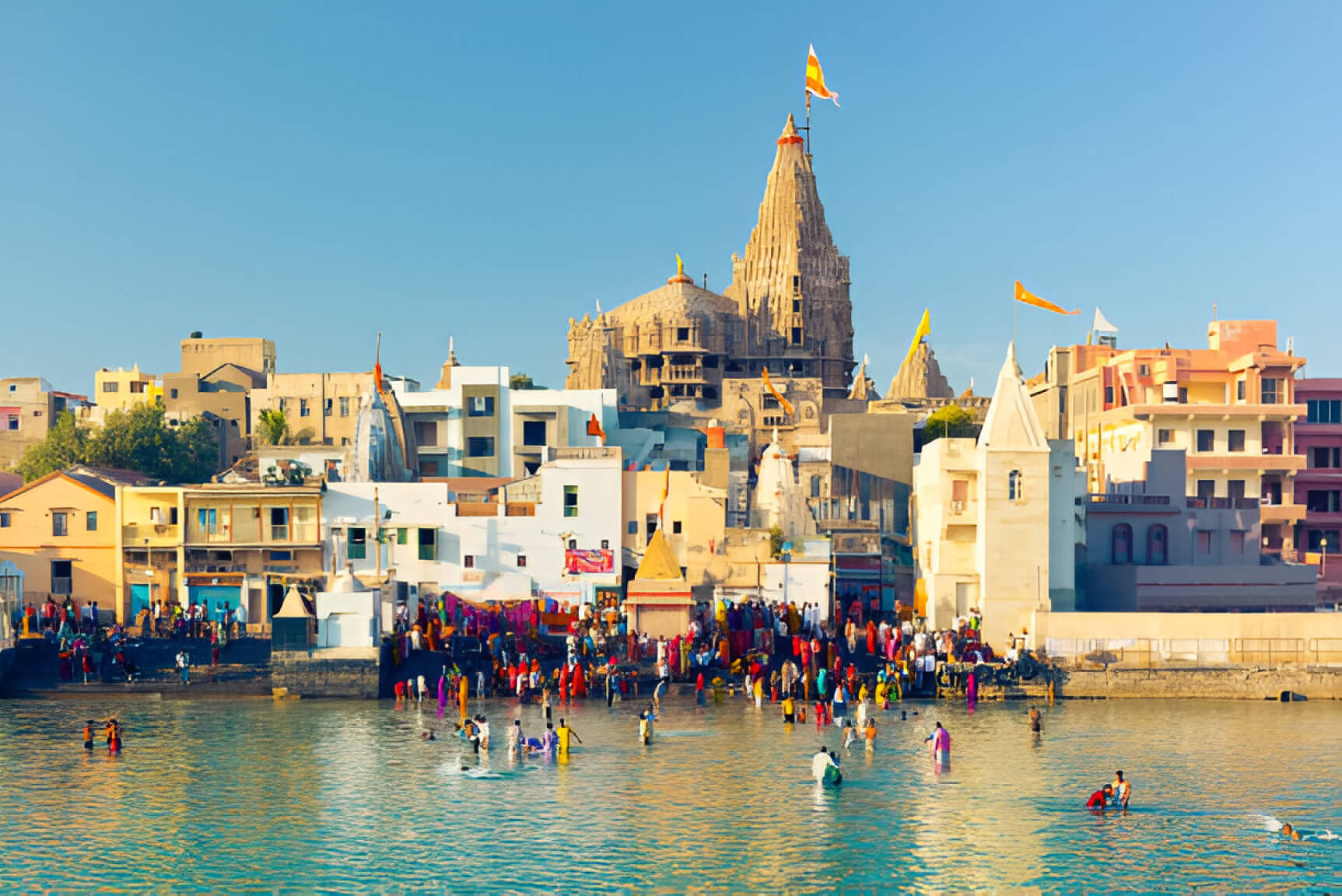
Lord Krishna’s City
After ruling from Mathura for some time Lord Krishna took his clan on a long exodus across north India to the coast of Gujarat. Here he built a new city by the sea for his Yadava clan that he called Dwaravati or Dwarka. It was a city that thrived as long as Krishna was alive and it vanished beneath the ocean waves at his death, as if it could only exist in the presence of its creator.
Lord Krishna was never forgotten here at Dwarka and his quicksilver spirit still pervades this tranquil sea side city. Here he is worshipped every day with lighted lamps, flowers, incense and mantras at the magnificent Dwarkadhish Temple. They sing bhajans in his praise and dance in mystic joy. At Dwarka he is still Dwarkadhish, the supreme lord of Dwarka.
Dwarka is mentioned extensively in the Mahabharata where many episodes in the life of the Pandava brothers of Hastinapur play out here. Arjun came to meet his dear friend often and would marry Krishna’s sister Subhadra. References to the city can also be found in the Harivamsa, Bhagavat Purana, Skanda Purana and Vishnu Purana. It is praised as a moksha kshetra, where devotees gain liberation from the cycle of birth and death. Today the stones of ancient Dwaravati may lie fathoms deep beneath the Arabian Sea but Krishna’s compassionate presence still beckons the pilgrim from every corner of the land.
Krishna’s Life
Krishna was born and brought up in the Mathura-Vrindavan region by the banks of the Yamuna River in today’s Uttar Pradesh. So why did he establish his kingdom at the other end of the sub continent in Dwarka in Gujarat? This extraordinary exodus of the Yadava clan is a fascinating tale found in the Mahabharata. It all began when Krishna and his older brother Balarama killed his uncle Kansa, the evil king of Mathura. Kansa had usurped the throne and then imprisoned his own father Ugrasen. Now Ugrasen was put back on the throne though the real king of Mathura was Krishna. Unfortunately this meant that Mathura gained an implacable enemy in Jarasandha, the powerful king of Magadha. Two of his daughters had been married to Kansa and so mighty Jarasandha would not forgive Krishna. Also Jarasandha was on a campaign of conquests and had defeated and captured many of the local kings but Krishna and his Yadava warriors were standing in his way.
Jarasandha attacked Mathura eighteen times and was defeated by Krishna every time but he refused to give up. Krishna was confident that he could defeat him again but the years of conflict had exhausted his people and peace had fled from the kingdom. Then the danger increased when Jarasandha’s ally Kalyavahan, the king of the Yavanas, decided to attack from the west as Jarasandha was gathering his army for the nineteenth invasion from the east.
Krishna now decided, for the sake of his people, to move away from this never ending conflict and led them across North India on a long exodus to distant Saurashtra. Here he selected a location that was protected by the sea on one side and by a ring of hills on the other. Dwarka was so well protected by nature that it never faced an attack by Jarasandha again. Krishna’s popular name at Dwarka reflects this tactical retreat, he is called Ranchhodji. ‘Ran’ means battlefield and ‘chhor’ means to leave, so Ranchhodji is a king who left the battlefield.
The founding of Dwarka
Officially first Ugrasen and then Balarama were the kings of Dwarka but in fact it was always Krishna who was the real leader of the Yadavas. Krishna built a port at Dwarka that made his kingdom very rich and prosperous. The sacred books say that Vishwakarma, the architect of the gods designed and built the city. He was creating an earthly version of Amaravati, the heavenly city of the gods and the land was not enough. Then Krishna begged the ocean god Samudra to lend him twelve yojanas of land for the city and Samudra agreed to his request and moved away.
Originally this place was called Kushasthali but now Krishna named his city Dwaravati. Dwar means a doorway and so Dwaravati was the gateway to moksha. The city rose on the banks of the Gomati River where it met the ocean and it had a harbour for ships. Vishwakarma filled the city fortress with beautiful palaces, temples, gardens and water pools.
There are long descriptions of this fabulous city in the Mahabharata and the Vishnu Purana. It says that the palaces of Krishna’s three queens Rukmini, Satyabhama and Jambavati were made of marble with silver doors. The pillars of Krishna’s palace were made of coral, set with jewels like sapphires and emeralds and embellished with intricate carvings. The canopies of silk were decorated with gold thread and edged with strings of pearls. The furniture was made of ivory inlaid with gold and the rooms were lit by jewelled lamps.
Then the clouds of war gathered over Dwarka. Jarasandha had not followed the Yadavas but his ally Kalyavahan had chased them to Dwarka. As his army was threatening the city, Krishna decided to tackle him alone. Making sure the Yavana king spotted him he raced away from the city on his chariot and lured his enemy into the hills. Then running on foot he climbed up and hid inside a cave. Kalyavahan followed and found a man asleep at the mouth of the cave. Thinking this was Krishna he kicked the sleeping figure to wake him and was instantly burnt to ashes.
Krishna had lured Kalyavahan to this cave for a reason. The sleeping man was a king named Muchkunda who had once helped the gods against the asuras. When Lord Brahma wanted to bless him, King Muchkunda asked for a very strange boon. He wanted to spend the rest of his life in slumber and if any one woke him up, that person should be burnt to ashes. So when unceremoniously kicked awake by Kalyavahan his fiery glance was enough to kill the yavana king. And once again Krishna had saved his people from a bloody conflict.
To tackle Jarasandha Krishna once again chose strategy instead of war. Also time was of the essence as Jarasandha had captured and kept ninety eight kings in captivity and he threatened to sacrifice them all to Shiva once the number had reached a hundred. Krishna and his friends the Pandava brothers Bhima and Arjuna entered Magadha in the disguise of Brahmins and Bhima challenged Jarasandha to a wrestling match and killed him.
Krishna and Balarama ruled Dwarka for thirty six years during which Krishna would play a prime role in the conflict between the Pandavas and their cousins the Kauravas that led to the devastating battle at Kurukshetra. Krishna’s close friendship with Arjuna is one of the highlights of the story and Krishna would be there at every juncture to advice his friend. At many moments of crisis during the battle Krishna’s advice would help the Pandavs.
Krishna in the Mahabharata
Krishna is the prime mover in the epic tale of the Mahabharata and here he is a king, warrior, statesman and also a philosopher. He is the most intricately imagined character in the epic and his multi faceted character has fascinated not just devotees but even scholars for centuries. The story of the epic is of the battle for power between two groups of cousins, the Kauravas and the Pandavas. The Kauravas ruled from Hastinapur and the Pandavas from Indraprastha. At a gambling match the Kauravas cheated and the eldest Pandava Yudhisthir lost everything including his kingdom, his brothers and even his wife Draupadi. The Pandavas watched in helpless rage as Draupadi was dragged into court and publicly humiliated. At this juncture Krishna came to the rescue of Draupadi and saved her from the clutches of the barbaric Dusshasan.
Soon war became inevitable and both sides began to gather allies for the mighty battle. Duryodhan the eldest Kaurava and Arjuna arrived at Dwarka to seek Krishna’s support. Krishna made it clear that he would not personally fight for any side and would only drive a warrior’s chariot. Then he offered Arjuna and Duryodhan a choice – they could take his army or his services as a charioteer. When Arjuna chose Krishna, Duryodhan knowing that Krishna would not fight, was pleased to take Krishna’s legendary Narayani army.
So the great Krishna, the most powerful and influential king, chose to play the role of a mere charioteer. As historian Irawati Karve writes, “The Pandavas did not lack warriors; what they needed was a dispassionate determined counsellor. That they found in Krishna.” It is this wisdom, strategic ability during a battle and guile of this supreme king that makes Krishna the true hero of the Mahabharata.
On the first day of battle, as the two armies stood ranged against each other, Arjuna faced a profound moral dilemma. Most of the warriors facing him were people he loved, how could he kill them? There were respected teachers, cousins, childhood friends and a beloved old grandfather. A despondent Arjuna laid down his bow and it was Krishna’s words that gave him the strength to pick it up again.
This long speech is enshrined as the Bhagavat Gita that teaches us our duties and then explains the concept of Karma Yoga. Today the Gita remains the most sacred and inspiring philosophy of the Hindus. It preaches of a life balancing duty and calm non-involvement, as Krishna says, “You can realise Brahman only by fulfilling the duties of your position on earth. Not ascetic retreat, but dispassionate, considered action is the only way to the Absolute.”
After the victory of the Pandavas at the Battle of Kurukshetra Krishna returned to rule at Dwarka. However he carried with him the burden of a great curse. All the hundred Kaurava brothers had been killed in battle and their mother Gandhari, had held Krishna responsible for their death. She cursed him that he would watch his clan destroy itself before his own eyes.
Legends of Dwarka
The terrible curse came true. As he watched helplessly, Krishna saw his beloved Dwarka become a decadent city full of arrogant, self indulgent men. The Yadavas had become fabulously wealthy and were soon so steeped in debauchery that Balarama had to ban the drinking of wine. However at a festival at Prabhas Patan they drank wine and soon began to kill each other in a drunken brawl. After Krishna saw his son Pradyumna and grandson Aniruddha being killed, he and Balarama lost all hope and withdrew into the forest. Here first Balarama breathed his last and then Krishna was killed by the poisoned arrow of a hunter. The hunter had seen Krishna’s feet and mistaken it for a deer and Krishna’s one vulnerable spot was his ankle. Then this avatar of Vishnu rose to heaven and was merged into the radiance of the god. With his death his city also came to an end as a huge tidal wave rose from the ocean and swept away the magnificent edifices of Dwarka.
Before his nirvana, Krishna had sent his charioteer Daruka to fetch his friend Arjuna. At Krishna’s request, Arjuna took the women and children of Dwarka back to Hastinapur. The Mahabharata has him describing the final moments of Dwarka’s end as Samudra, the god of the oceans, reclaimed the land he had loaned to Krishna. As the mighty waves swept in, “I saw the beautiful buildings becoming submerged one by one. In a matter of a few moments it was all over. The sea had now become as placid as a lake. There was no trace of the city. Dwarka was just a name, just a memory.”
With the death of Krishna the third of the Hindu ages, Dvapar Yuga ends and the Kali Yuga begins. Later Krishna’s great grandson Vajranabha, the son of Aniruddha began to rule from Mathura. He came back to the sea coast of Dwarka to build a temple in the memory of Krishna and this was the original Dwarkadhish Temple. The temple was built at the site of a palace called Harigriha which was Krishna’s personal palace. Here in the sanctum sanctorum, the garbha griha of the temple, Vajranabha installed an image of Krishna as the magnificent king of Dwarka.
Dwarka is one of the most sacred among the Vaishnava tirthas. Here Vishnu’s eight avatar Krishna is Dwarkadhish and Dwarkanath, the lord of the city. He is also affectionately called Ranchhodji, the king who left the scene of a battle and he is Trivikrama, the magnificent king of the three worlds.
Find Your Perfect Read
Explore More
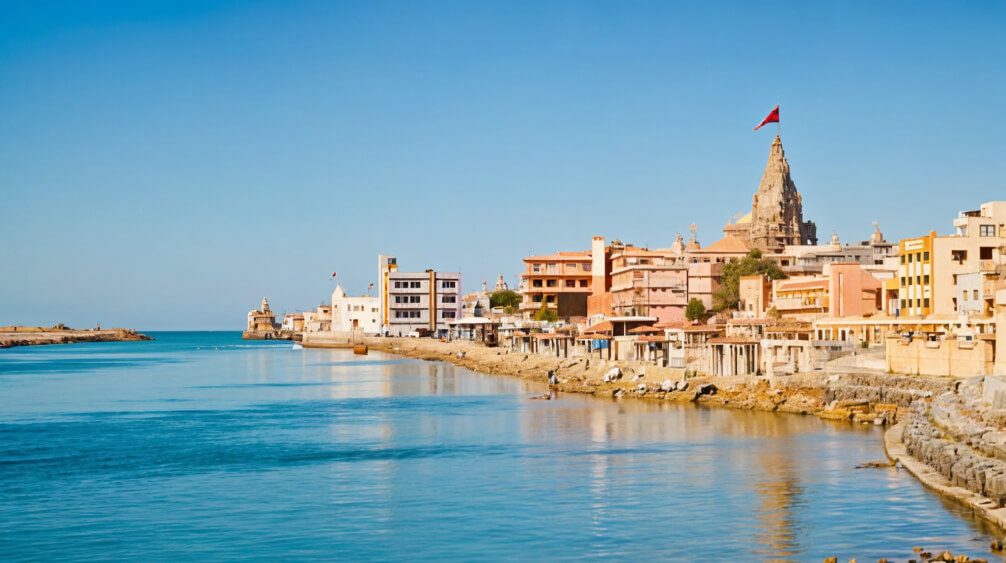
Dwarka
At the heart of Dwarka city stands the temple with the high shikhara from which a huge saffron flag flies…
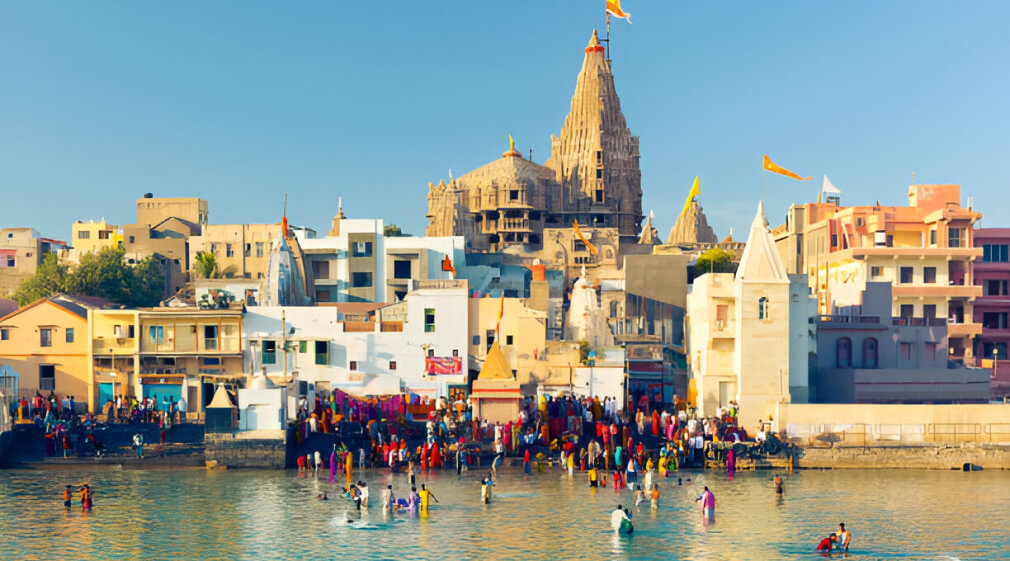
Lord Krishna’s City
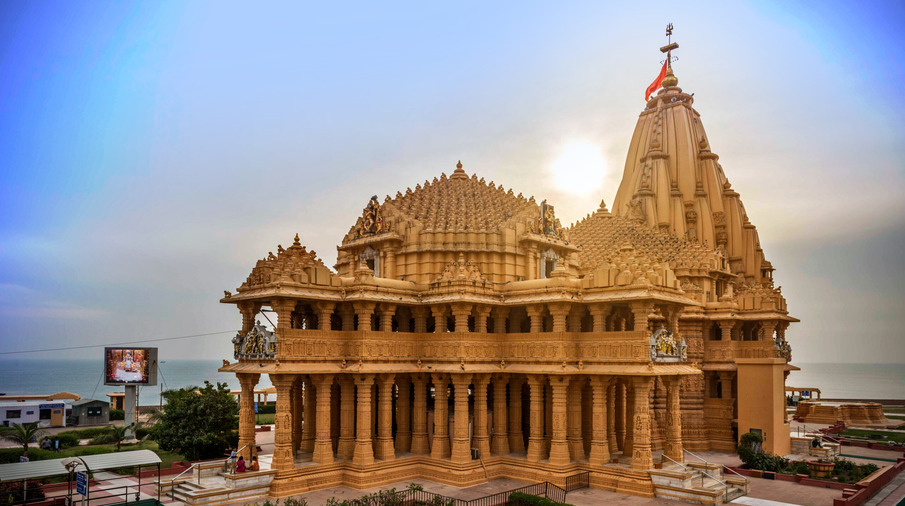
Dwarkadhish Temple
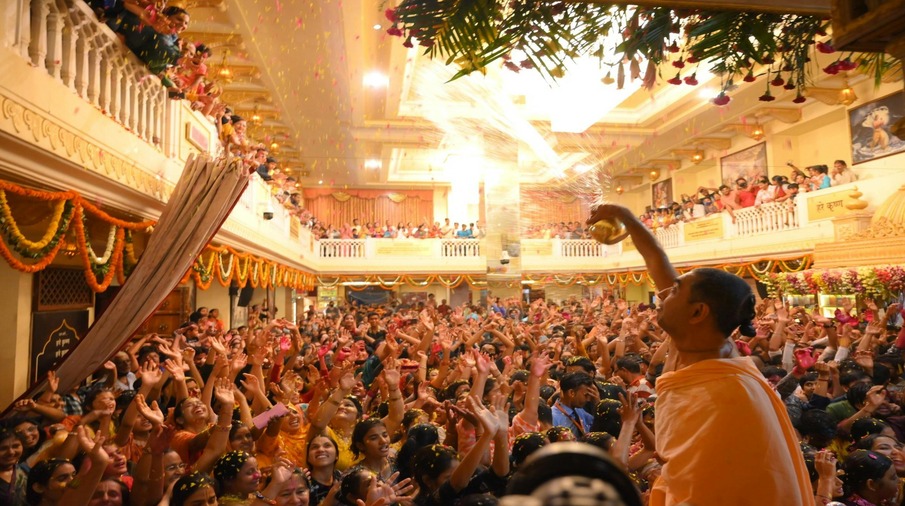
Pujas & Festivals
The most important festival at the Dwarkadhish Temple is Janamashtami, the day of Lord Krishna’s birth...
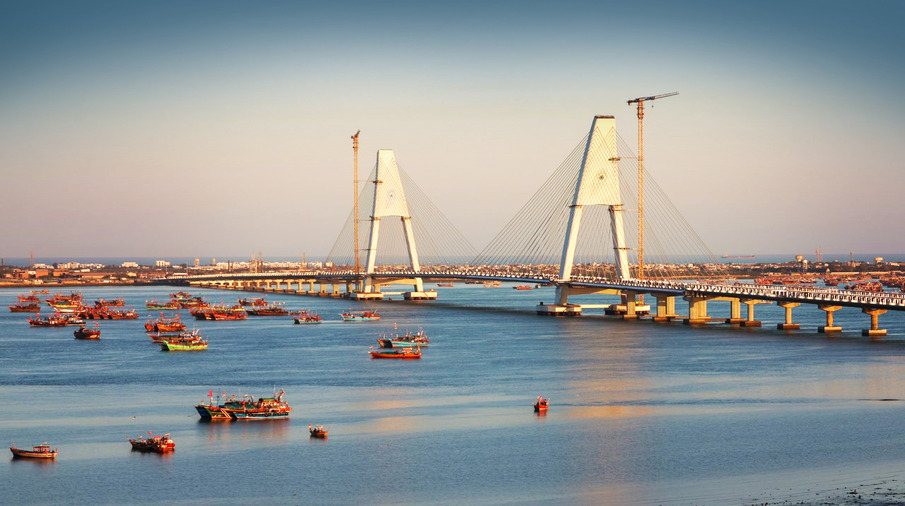
Other Places of Interest
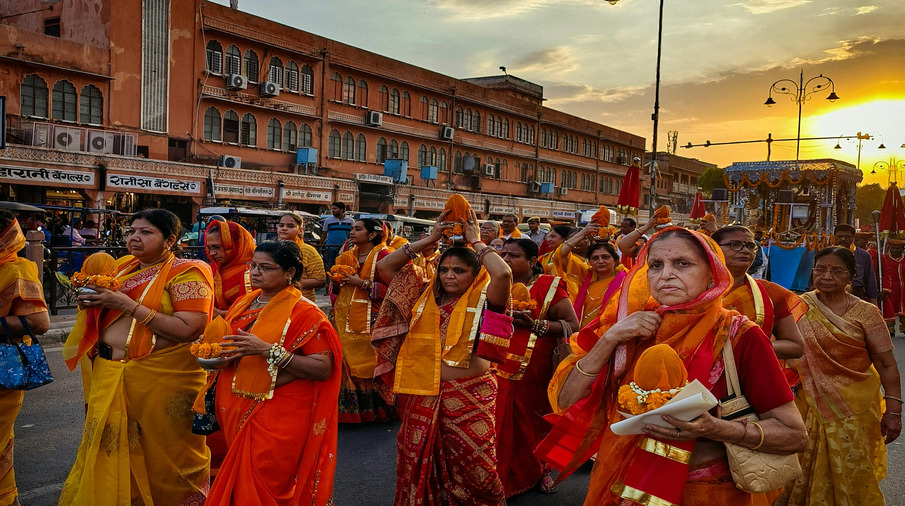
Travelling to Dwarka
Dwarka is in the state of Gujarat and stands on the Arabian Sea by the west coast of India in the Jamnagar...

